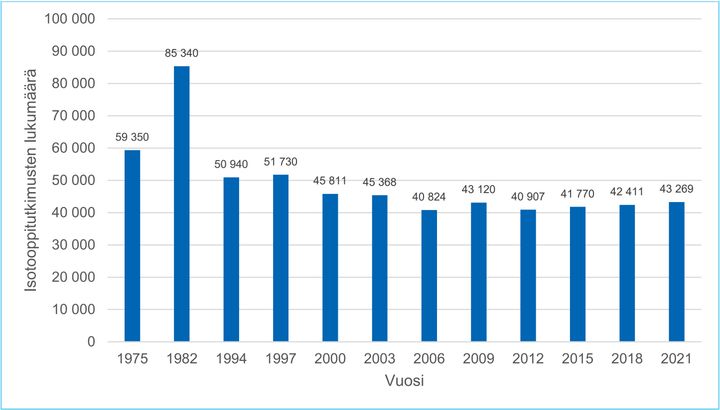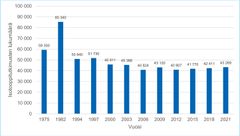Number of nuclear medicine examinations unchanged, therapy volumes increasing

The Radiation and Nuclear Safety Authority (STUK) report "Nuclear medicine examinations and treatments in Finland in 2021", published in February 2023, presents the numbers of examinations, treatments and nuclear imaging equipment, and estimates the radiation exposure caused to adults by the examinations.
Inspector Iida Kuurne, the author of the report, says that the study examined the average radiation dose from nuclear medicine examinations carried out 2021 and the total combined radiation doses of Finns.
According to Iida Kuurne, the results show that only a small part of the radiation dose received by Finns is caused by nuclear medicine examinations. An adult participating in a single nuclear medicine examination receives an average dose of 3.4 millisieverts (mSv) from radiopharmaceuticals and a dose of 2.1 mSv from a CT scan, if this is done in addition to the nuclear medicine examination.
When the radiation exposure caused by nuclear medicine examinations is divided among all Finns, the radiation dose is less than 0.05 mSv per citizen per year. The dose has increased slightly in the last ten years. The increase is due to increased CT scans. The average radiation dose received by Finns from all sources combined is 5.9 millisieverts per year. More than five millisieverts come from natural radioactive materials, mainly radon.
The total number of nuclear medicine examinations has remained stable for the last 20 years. The most common nuclear medicine examinations were tumour imaging, examinations of skeletal and soft parts, and examinations of the circulatory system. The most widely used radioactive substances in imaging were technetium-99m, fluorine-18 and iodine-123.
The number of radionuclide therapies has increased every year in the last ten years. Compared to 2009, 58% more treatments were given in 2021. The most common radionuclide therapies are treatment of hyperthyroidism and cancer. The increase in the number of radionuclide therapies is due to new types of treatments that use, for example, Lutetium-177 for the treatment of prostate cancer. The most widely used radioactive substances in radionuclide therapies were iodine-131, lutetium-177 and radium-223.
In radionuclide therapies, as in other radiotherapies, radiation must be used sufficiently to obtain a therapeutic effect. It is international practice not to take radiation exposure into account when calculating the total exposure of citizens.
Keywords
Contacts
Inspector Iida Kuurne, tel. +358 9 759 88 2626
Senior Inspector Sampsa Kaijaluoto, tel. +358 9 759 88 2542
Media contacts, tel. +358 10 850 4761
Images

Links
About Säteilyturvakeskus (STUK)
Säteilyturvakeskus (STUK) on säteily- ja ydinturvallisuutta valvova viranomainen. Tehtävämme on ihmisten, yhteiskunnan, ympäristön ja tulevien sukupolvien suojelu säteilyn haitallisilta vaikutuksilta. STUKissa oli vuoden 2022 alussa yhteensä 336 työntekijää.
Strålsäkerhetscentralen (STUK) är en myndighet som övervakar strål- och kärnsäkerheten. Vårt uppdrag är att skydda människorna, samhället, miljön och de framtida generationerna för strålningens skadliga konsekvenser. I början av 2022 hade STUK sammanlagt 336 anställda.
Radiation and Nuclear Safety Authority (STUK) supervises radiation and nuclear safety in Finland. Our mission is to protect people, society, the environment and future generations from the detrimental effects of radiation. At the beginning of 2022 STUK had 336 employees.
Subscribe to releases from Säteilyturvakeskus (STUK)
Subscribe to all the latest releases from Säteilyturvakeskus (STUK) by registering your e-mail address below. You can unsubscribe at any time.
Latest releases from Säteilyturvakeskus (STUK)
STUK:s luftinsamlare fångade radioaktivt brom18.12.2025 11:12:26 EET | Pressmeddelande
Strålsäkerhetscentralen upptäckte en ofarlig liten mängd radioaktivt brom i utomhusluften i Vanda i ett prov som samlades in den 11-12 december. Brom kan härstamma till exempel från en spårämnesmätning som har utförts korrekt i en industrifacilitet, där en radioaktiv isotop av brom har använts som spårämne.
STUKin ilmankerääjään tarttui radioaktiivsta bromia18.12.2025 11:12:26 EET | Tiedote
Säteilyturvakeskus havaitsi Vantaan ulkoilmassa haitattoman pienen määrän radioaktiivista bromia joulukuun 11.-12. kerätyssä näytteessä. Bromi voi olla peräisin esimerkiksi teollisuuslaitoksessa asiallisesti tehdystä kokeesta, jossa bromin radioaktiivista isotooppia on käytetty merkkiaineena.
Radonhalten i hemmet kan inte fastställas utifrån grannbostadens mätresultat15.12.2025 11:32:26 EET | Pressmeddelande
Enligt en utredning av Strålsäkerhetscentralen kan radonhalterna variera betydligt i samma husbolags bostäder. Radonhalten är inte konstant ens i en enskild bostad. Radonbekämpningen i byggskedet av nya hus och radonsaneringen i ett senare skede fungerar länge, men uppföljningen är viktig.
Kodin radonpitoisuutta ei voi päätellä naapuriasunnon mittaustuloksesta15.12.2025 11:32:26 EET | Tiedote
Säteilyturvakeskuksen selvityksen mukaan radonpitoisuudet voivat vaihdella saman taloyhtiön asunnoissa merkittävästi. Radonpitoisuus ei ole vakio edes yksittäisessä asunnossa. Uusien talojen rakennusvaiheen radontorjunta sekä myöhemmän vaiheen radonkorjaukset toimivat pitkään, mutta seuranta on tärkeää.
You cannot conclude your home’s radon concentration from the results measured in the neighbouring dwelling15.12.2025 11:32:26 EET | Press release
According to a report by the Radiation and Nuclear Safety Authority, radon concentrations may vary significantly between the dwellings within the same housing company. Radon concentration does not remain constant even in an individual dwelling. Radon prevention in the construction phase of new houses and radon mitigation measures in later stages work for a long time, but monitoring is important.
In our pressroom you can read all our latest releases, find our press contacts, images, documents and other relevant information about us.
Visit our pressroom
